Collective Action Against Corruption: Strategies and Impact Analysis
VerifiedAdded on 2022/08/29
|8
|1772
|17
Report
AI Summary
This report analyzes the significance of collective action in combating corruption, focusing on its impact on destabilized local laws and corruptive practices. It explores various forms of collective action, from immediate consensuses to long-standing efforts, highlighting the efficiency of collaborative approaches compared to individual actions. The report discusses the role of collective action in public and private sectors, including SMEs and large enterprises, and examines initiatives like the B20 Task Force, the B-Team, and the MACN. It emphasizes the multifaceted nature of corruption and the need for businesses to take responsibility in providing solutions. The report further explores successful collaborative anti-corruption actions, such as the Pacto Etico Commercial in Paraguay, and concludes that collaboration between public and private actors is crucial in addressing corruption. The report also provides insights into the benefits of such partnerships in promoting good business practices and fostering a more ethical and transparent environment. The report uses various sources and case studies to support its findings and recommendations.
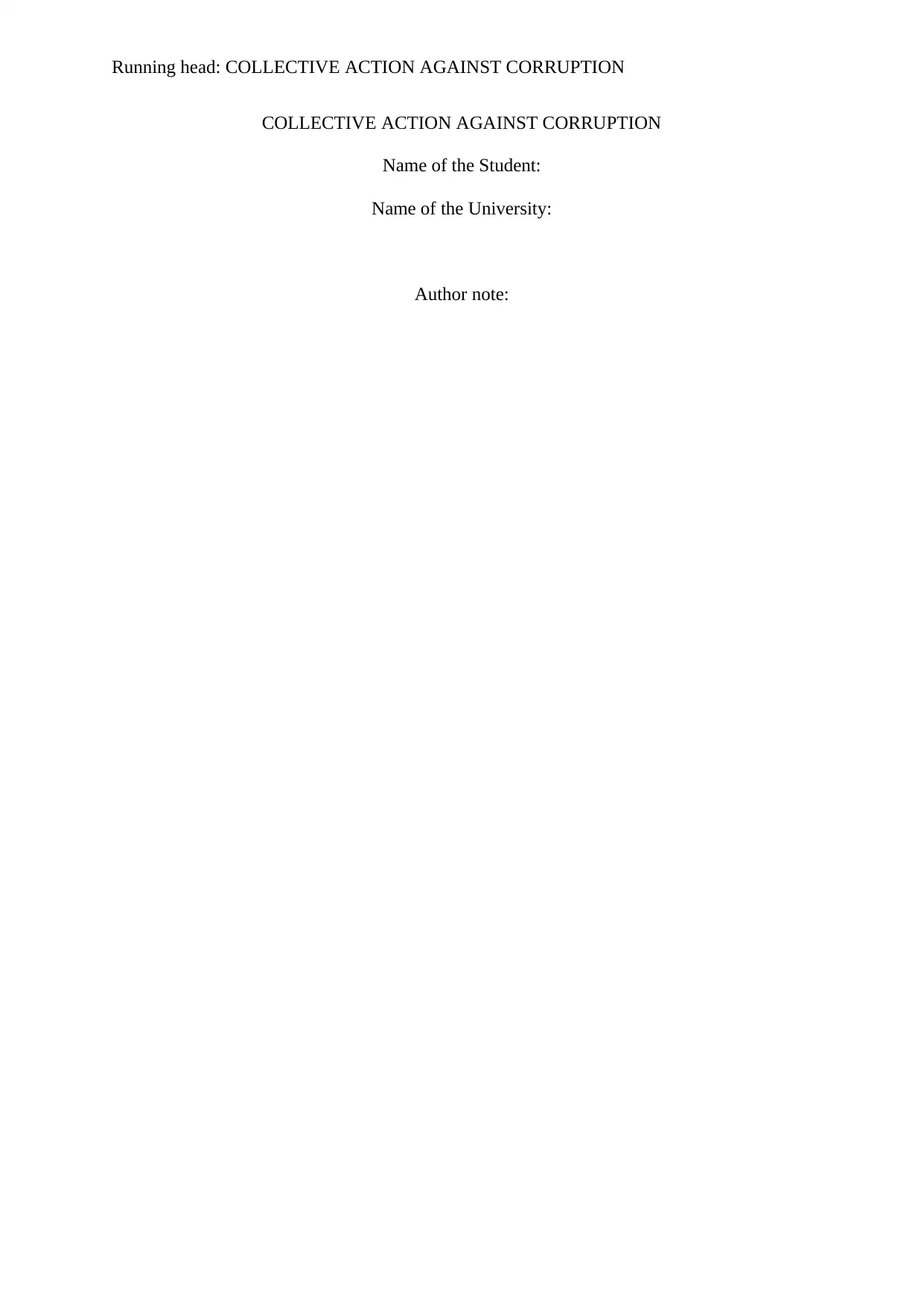
Running head: COLLECTIVE ACTION AGAINST CORRUPTION
COLLECTIVE ACTION AGAINST CORRUPTION
Name of the Student:
Name of the University:
Author note:
COLLECTIVE ACTION AGAINST CORRUPTION
Name of the Student:
Name of the University:
Author note:
Paraphrase This Document
Need a fresh take? Get an instant paraphrase of this document with our AI Paraphraser
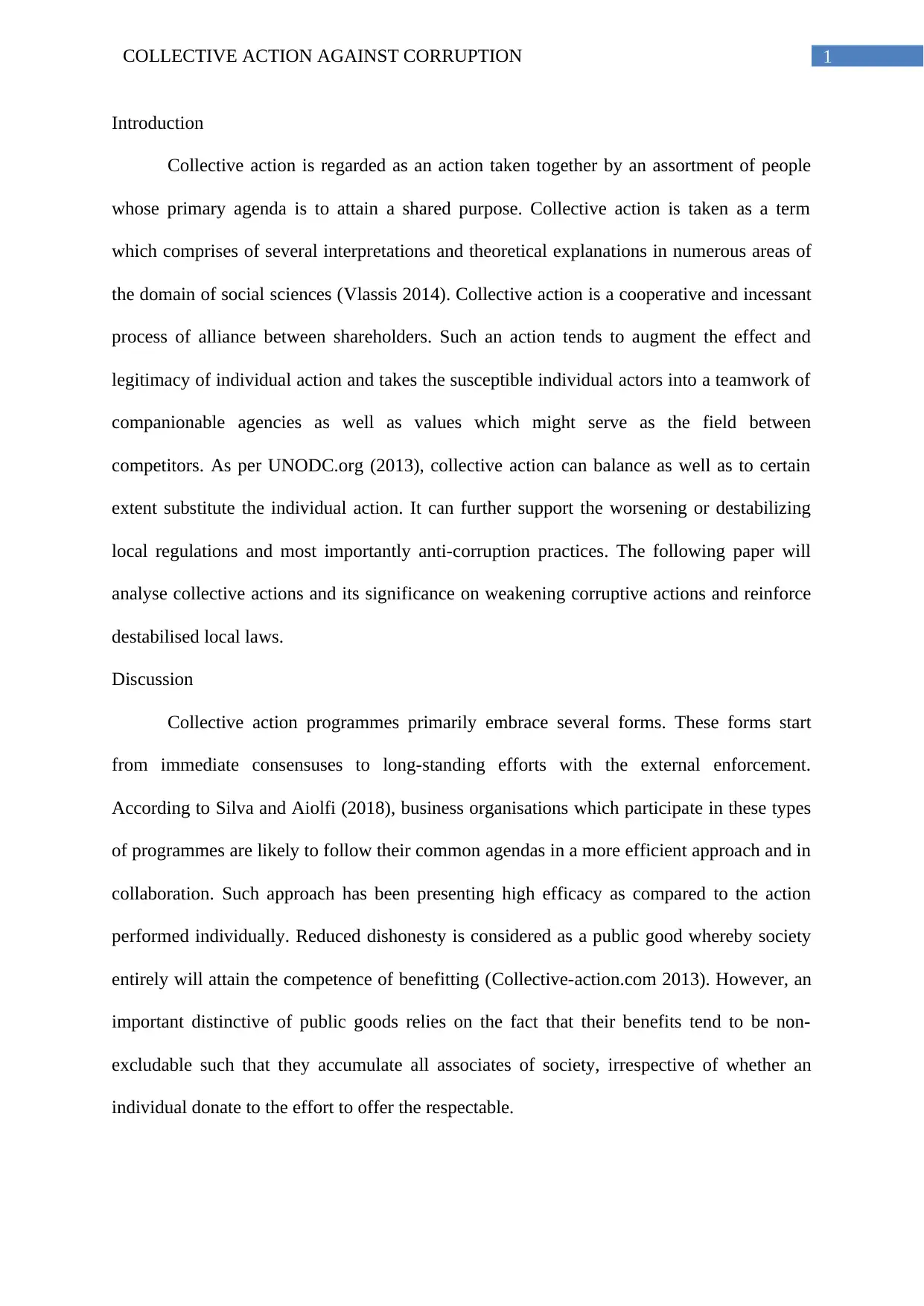
1COLLECTIVE ACTION AGAINST CORRUPTION
Introduction
Collective action is regarded as an action taken together by an assortment of people
whose primary agenda is to attain a shared purpose. Collective action is taken as a term
which comprises of several interpretations and theoretical explanations in numerous areas of
the domain of social sciences (Vlassis 2014). Collective action is a cooperative and incessant
process of alliance between shareholders. Such an action tends to augment the effect and
legitimacy of individual action and takes the susceptible individual actors into a teamwork of
companionable agencies as well as values which might serve as the field between
competitors. As per UNODC.org (2013), collective action can balance as well as to certain
extent substitute the individual action. It can further support the worsening or destabilizing
local regulations and most importantly anti-corruption practices. The following paper will
analyse collective actions and its significance on weakening corruptive actions and reinforce
destabilised local laws.
Discussion
Collective action programmes primarily embrace several forms. These forms start
from immediate consensuses to long-standing efforts with the external enforcement.
According to Silva and Aiolfi (2018), business organisations which participate in these types
of programmes are likely to follow their common agendas in a more efficient approach and in
collaboration. Such approach has been presenting high efficacy as compared to the action
performed individually. Reduced dishonesty is considered as a public good whereby society
entirely will attain the competence of benefitting (Collective-action.com 2013). However, an
important distinctive of public goods relies on the fact that their benefits tend to be non-
excludable such that they accumulate all associates of society, irrespective of whether an
individual donate to the effort to offer the respectable.
Introduction
Collective action is regarded as an action taken together by an assortment of people
whose primary agenda is to attain a shared purpose. Collective action is taken as a term
which comprises of several interpretations and theoretical explanations in numerous areas of
the domain of social sciences (Vlassis 2014). Collective action is a cooperative and incessant
process of alliance between shareholders. Such an action tends to augment the effect and
legitimacy of individual action and takes the susceptible individual actors into a teamwork of
companionable agencies as well as values which might serve as the field between
competitors. As per UNODC.org (2013), collective action can balance as well as to certain
extent substitute the individual action. It can further support the worsening or destabilizing
local regulations and most importantly anti-corruption practices. The following paper will
analyse collective actions and its significance on weakening corruptive actions and reinforce
destabilised local laws.
Discussion
Collective action programmes primarily embrace several forms. These forms start
from immediate consensuses to long-standing efforts with the external enforcement.
According to Silva and Aiolfi (2018), business organisations which participate in these types
of programmes are likely to follow their common agendas in a more efficient approach and in
collaboration. Such approach has been presenting high efficacy as compared to the action
performed individually. Reduced dishonesty is considered as a public good whereby society
entirely will attain the competence of benefitting (Collective-action.com 2013). However, an
important distinctive of public goods relies on the fact that their benefits tend to be non-
excludable such that they accumulate all associates of society, irrespective of whether an
individual donate to the effort to offer the respectable.
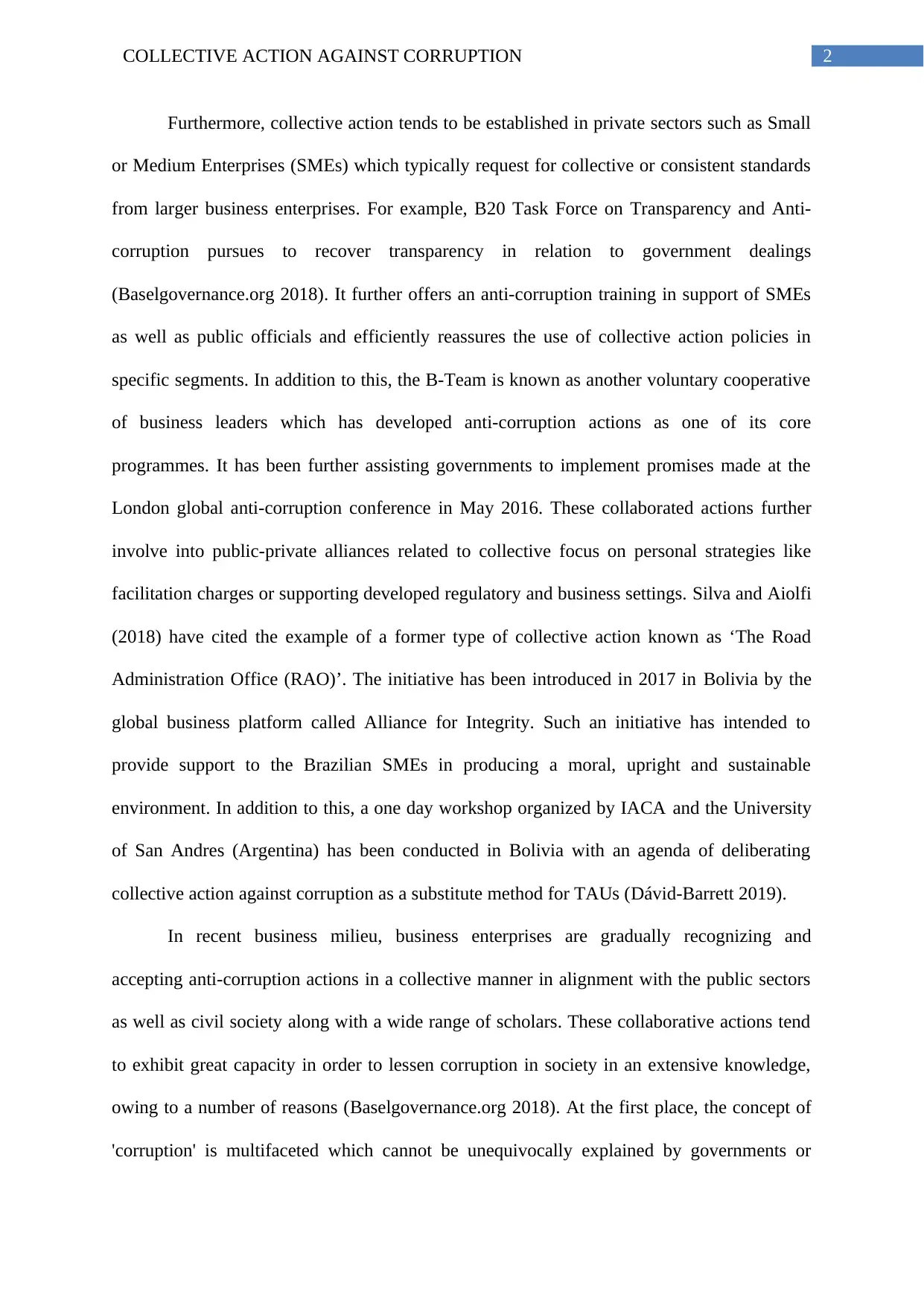
2COLLECTIVE ACTION AGAINST CORRUPTION
Furthermore, collective action tends to be established in private sectors such as Small
or Medium Enterprises (SMEs) which typically request for collective or consistent standards
from larger business enterprises. For example, B20 Task Force on Transparency and Anti-
corruption pursues to recover transparency in relation to government dealings
(Baselgovernance.org 2018). It further offers an anti-corruption training in support of SMEs
as well as public officials and efficiently reassures the use of collective action policies in
specific segments. In addition to this, the B-Team is known as another voluntary cooperative
of business leaders which has developed anti-corruption actions as one of its core
programmes. It has been further assisting governments to implement promises made at the
London global anti-corruption conference in May 2016. These collaborated actions further
involve into public-private alliances related to collective focus on personal strategies like
facilitation charges or supporting developed regulatory and business settings. Silva and Aiolfi
(2018) have cited the example of a former type of collective action known as ‘The Road
Administration Office (RAO)’. The initiative has been introduced in 2017 in Bolivia by the
global business platform called Alliance for Integrity. Such an initiative has intended to
provide support to the Brazilian SMEs in producing a moral, upright and sustainable
environment. In addition to this, a one day workshop organized by IACA and the University
of San Andres (Argentina) has been conducted in Bolivia with an agenda of deliberating
collective action against corruption as a substitute method for TAUs (Dávid-Barrett 2019).
In recent business milieu, business enterprises are gradually recognizing and
accepting anti-corruption actions in a collective manner in alignment with the public sectors
as well as civil society along with a wide range of scholars. These collaborative actions tend
to exhibit great capacity in order to lessen corruption in society in an extensive knowledge,
owing to a number of reasons (Baselgovernance.org 2018). At the first place, the concept of
'corruption' is multifaceted which cannot be unequivocally explained by governments or
Furthermore, collective action tends to be established in private sectors such as Small
or Medium Enterprises (SMEs) which typically request for collective or consistent standards
from larger business enterprises. For example, B20 Task Force on Transparency and Anti-
corruption pursues to recover transparency in relation to government dealings
(Baselgovernance.org 2018). It further offers an anti-corruption training in support of SMEs
as well as public officials and efficiently reassures the use of collective action policies in
specific segments. In addition to this, the B-Team is known as another voluntary cooperative
of business leaders which has developed anti-corruption actions as one of its core
programmes. It has been further assisting governments to implement promises made at the
London global anti-corruption conference in May 2016. These collaborated actions further
involve into public-private alliances related to collective focus on personal strategies like
facilitation charges or supporting developed regulatory and business settings. Silva and Aiolfi
(2018) have cited the example of a former type of collective action known as ‘The Road
Administration Office (RAO)’. The initiative has been introduced in 2017 in Bolivia by the
global business platform called Alliance for Integrity. Such an initiative has intended to
provide support to the Brazilian SMEs in producing a moral, upright and sustainable
environment. In addition to this, a one day workshop organized by IACA and the University
of San Andres (Argentina) has been conducted in Bolivia with an agenda of deliberating
collective action against corruption as a substitute method for TAUs (Dávid-Barrett 2019).
In recent business milieu, business enterprises are gradually recognizing and
accepting anti-corruption actions in a collective manner in alignment with the public sectors
as well as civil society along with a wide range of scholars. These collaborative actions tend
to exhibit great capacity in order to lessen corruption in society in an extensive knowledge,
owing to a number of reasons (Baselgovernance.org 2018). At the first place, the concept of
'corruption' is multifaceted which cannot be unequivocally explained by governments or
⊘ This is a preview!⊘
Do you want full access?
Subscribe today to unlock all pages.

Trusted by 1+ million students worldwide
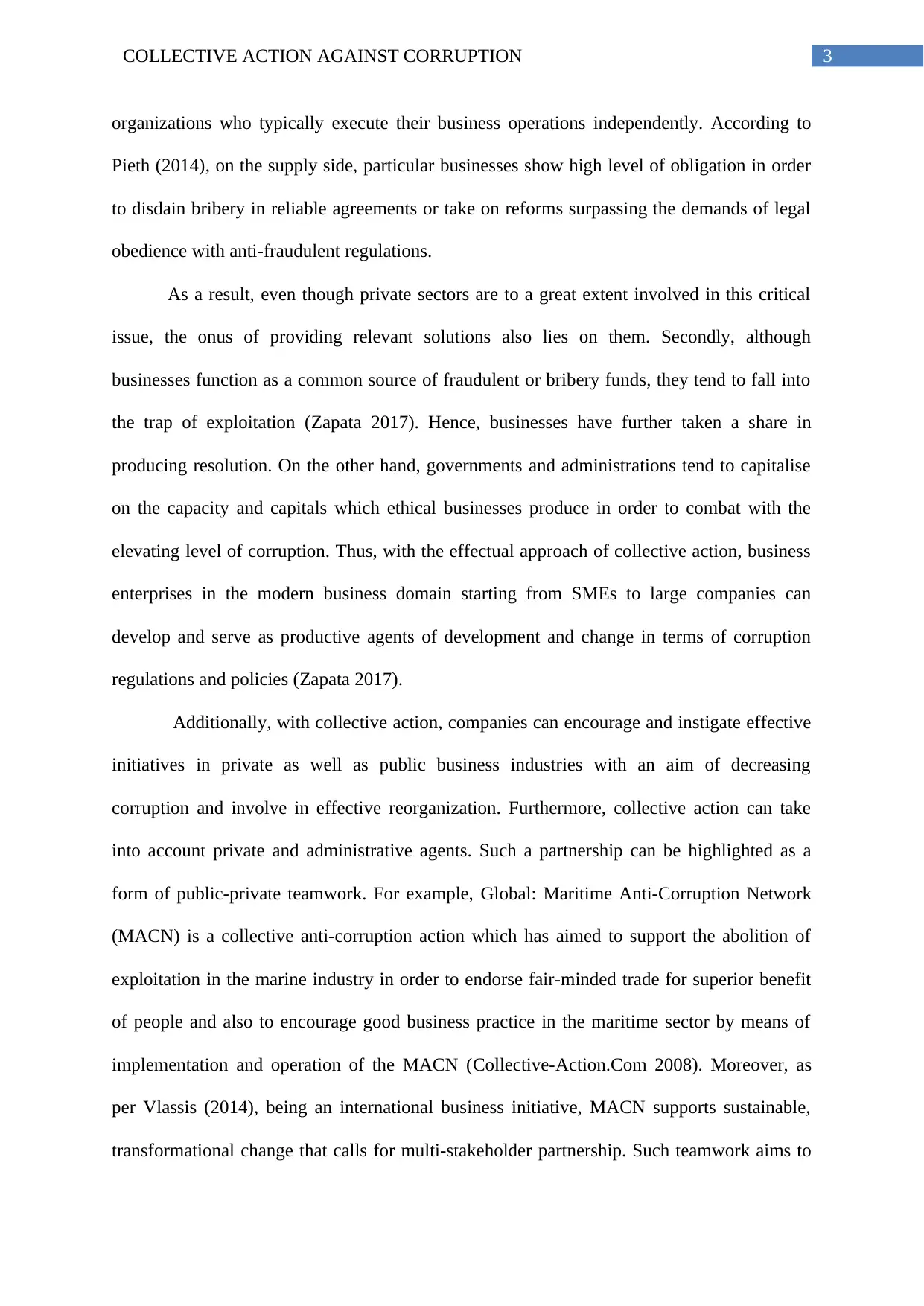
3COLLECTIVE ACTION AGAINST CORRUPTION
organizations who typically execute their business operations independently. According to
Pieth (2014), on the supply side, particular businesses show high level of obligation in order
to disdain bribery in reliable agreements or take on reforms surpassing the demands of legal
obedience with anti-fraudulent regulations.
As a result, even though private sectors are to a great extent involved in this critical
issue, the onus of providing relevant solutions also lies on them. Secondly, although
businesses function as a common source of fraudulent or bribery funds, they tend to fall into
the trap of exploitation (Zapata 2017). Hence, businesses have further taken a share in
producing resolution. On the other hand, governments and administrations tend to capitalise
on the capacity and capitals which ethical businesses produce in order to combat with the
elevating level of corruption. Thus, with the effectual approach of collective action, business
enterprises in the modern business domain starting from SMEs to large companies can
develop and serve as productive agents of development and change in terms of corruption
regulations and policies (Zapata 2017).
Additionally, with collective action, companies can encourage and instigate effective
initiatives in private as well as public business industries with an aim of decreasing
corruption and involve in effective reorganization. Furthermore, collective action can take
into account private and administrative agents. Such a partnership can be highlighted as a
form of public-private teamwork. For example, Global: Maritime Anti-Corruption Network
(MACN) is a collective anti-corruption action which has aimed to support the abolition of
exploitation in the marine industry in order to endorse fair-minded trade for superior benefit
of people and also to encourage good business practice in the maritime sector by means of
implementation and operation of the MACN (Collective-Action.Com 2008). Moreover, as
per Vlassis (2014), being an international business initiative, MACN supports sustainable,
transformational change that calls for multi-stakeholder partnership. Such teamwork aims to
organizations who typically execute their business operations independently. According to
Pieth (2014), on the supply side, particular businesses show high level of obligation in order
to disdain bribery in reliable agreements or take on reforms surpassing the demands of legal
obedience with anti-fraudulent regulations.
As a result, even though private sectors are to a great extent involved in this critical
issue, the onus of providing relevant solutions also lies on them. Secondly, although
businesses function as a common source of fraudulent or bribery funds, they tend to fall into
the trap of exploitation (Zapata 2017). Hence, businesses have further taken a share in
producing resolution. On the other hand, governments and administrations tend to capitalise
on the capacity and capitals which ethical businesses produce in order to combat with the
elevating level of corruption. Thus, with the effectual approach of collective action, business
enterprises in the modern business domain starting from SMEs to large companies can
develop and serve as productive agents of development and change in terms of corruption
regulations and policies (Zapata 2017).
Additionally, with collective action, companies can encourage and instigate effective
initiatives in private as well as public business industries with an aim of decreasing
corruption and involve in effective reorganization. Furthermore, collective action can take
into account private and administrative agents. Such a partnership can be highlighted as a
form of public-private teamwork. For example, Global: Maritime Anti-Corruption Network
(MACN) is a collective anti-corruption action which has aimed to support the abolition of
exploitation in the marine industry in order to endorse fair-minded trade for superior benefit
of people and also to encourage good business practice in the maritime sector by means of
implementation and operation of the MACN (Collective-Action.Com 2008). Moreover, as
per Vlassis (2014), being an international business initiative, MACN supports sustainable,
transformational change that calls for multi-stakeholder partnership. Such teamwork aims to
Paraphrase This Document
Need a fresh take? Get an instant paraphrase of this document with our AI Paraphraser
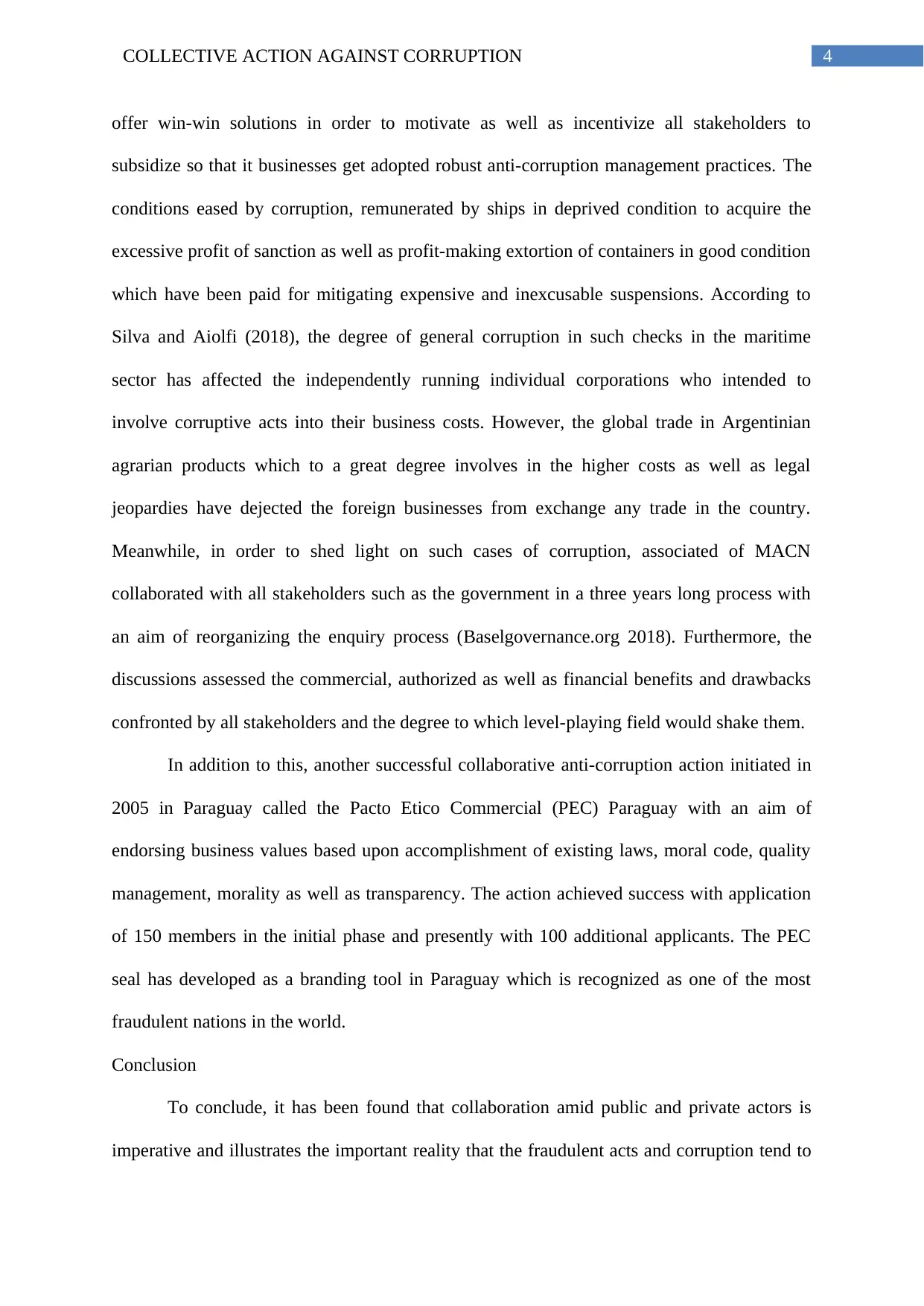
4COLLECTIVE ACTION AGAINST CORRUPTION
offer win-win solutions in order to motivate as well as incentivize all stakeholders to
subsidize so that it businesses get adopted robust anti-corruption management practices. The
conditions eased by corruption, remunerated by ships in deprived condition to acquire the
excessive profit of sanction as well as profit-making extortion of containers in good condition
which have been paid for mitigating expensive and inexcusable suspensions. According to
Silva and Aiolfi (2018), the degree of general corruption in such checks in the maritime
sector has affected the independently running individual corporations who intended to
involve corruptive acts into their business costs. However, the global trade in Argentinian
agrarian products which to a great degree involves in the higher costs as well as legal
jeopardies have dejected the foreign businesses from exchange any trade in the country.
Meanwhile, in order to shed light on such cases of corruption, associated of MACN
collaborated with all stakeholders such as the government in a three years long process with
an aim of reorganizing the enquiry process (Baselgovernance.org 2018). Furthermore, the
discussions assessed the commercial, authorized as well as financial benefits and drawbacks
confronted by all stakeholders and the degree to which level-playing field would shake them.
In addition to this, another successful collaborative anti-corruption action initiated in
2005 in Paraguay called the Pacto Etico Commercial (PEC) Paraguay with an aim of
endorsing business values based upon accomplishment of existing laws, moral code, quality
management, morality as well as transparency. The action achieved success with application
of 150 members in the initial phase and presently with 100 additional applicants. The PEC
seal has developed as a branding tool in Paraguay which is recognized as one of the most
fraudulent nations in the world.
Conclusion
To conclude, it has been found that collaboration amid public and private actors is
imperative and illustrates the important reality that the fraudulent acts and corruption tend to
offer win-win solutions in order to motivate as well as incentivize all stakeholders to
subsidize so that it businesses get adopted robust anti-corruption management practices. The
conditions eased by corruption, remunerated by ships in deprived condition to acquire the
excessive profit of sanction as well as profit-making extortion of containers in good condition
which have been paid for mitigating expensive and inexcusable suspensions. According to
Silva and Aiolfi (2018), the degree of general corruption in such checks in the maritime
sector has affected the independently running individual corporations who intended to
involve corruptive acts into their business costs. However, the global trade in Argentinian
agrarian products which to a great degree involves in the higher costs as well as legal
jeopardies have dejected the foreign businesses from exchange any trade in the country.
Meanwhile, in order to shed light on such cases of corruption, associated of MACN
collaborated with all stakeholders such as the government in a three years long process with
an aim of reorganizing the enquiry process (Baselgovernance.org 2018). Furthermore, the
discussions assessed the commercial, authorized as well as financial benefits and drawbacks
confronted by all stakeholders and the degree to which level-playing field would shake them.
In addition to this, another successful collaborative anti-corruption action initiated in
2005 in Paraguay called the Pacto Etico Commercial (PEC) Paraguay with an aim of
endorsing business values based upon accomplishment of existing laws, moral code, quality
management, morality as well as transparency. The action achieved success with application
of 150 members in the initial phase and presently with 100 additional applicants. The PEC
seal has developed as a branding tool in Paraguay which is recognized as one of the most
fraudulent nations in the world.
Conclusion
To conclude, it has been found that collaboration amid public and private actors is
imperative and illustrates the important reality that the fraudulent acts and corruption tend to
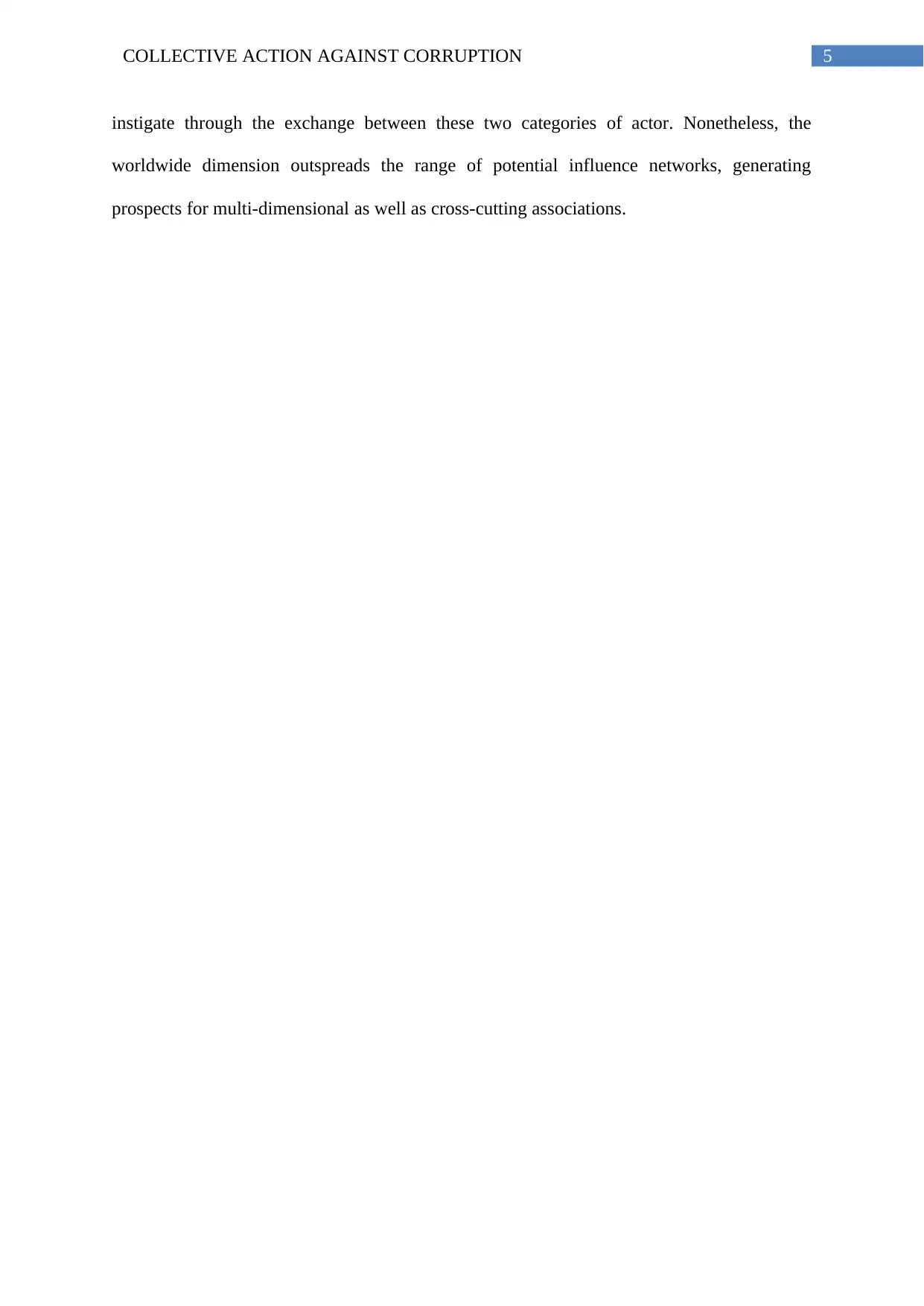
5COLLECTIVE ACTION AGAINST CORRUPTION
instigate through the exchange between these two categories of actor. Nonetheless, the
worldwide dimension outspreads the range of potential influence networks, generating
prospects for multi-dimensional as well as cross-cutting associations.
instigate through the exchange between these two categories of actor. Nonetheless, the
worldwide dimension outspreads the range of potential influence networks, generating
prospects for multi-dimensional as well as cross-cutting associations.
⊘ This is a preview!⊘
Do you want full access?
Subscribe today to unlock all pages.

Trusted by 1+ million students worldwide
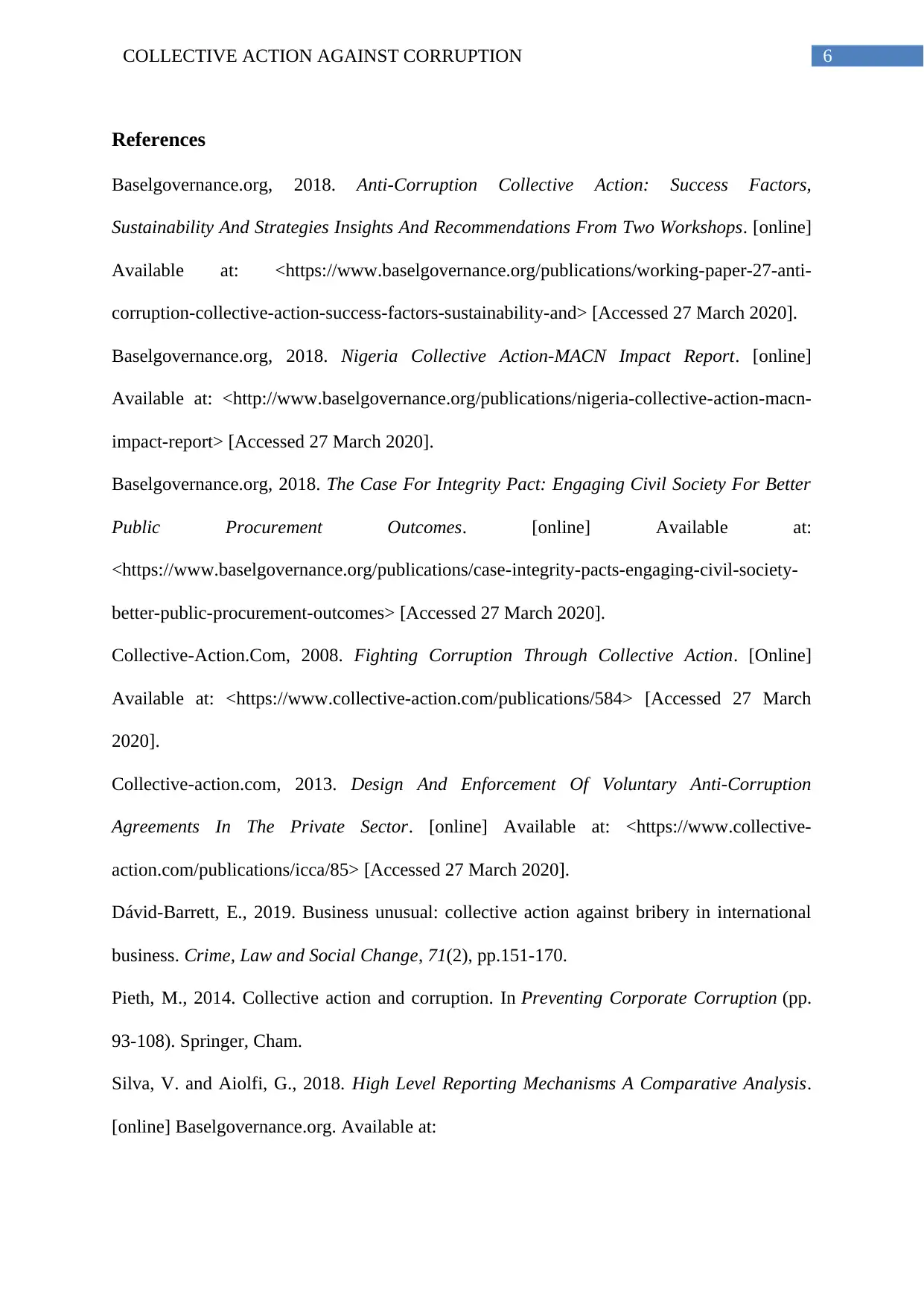
6COLLECTIVE ACTION AGAINST CORRUPTION
References
Baselgovernance.org, 2018. Anti-Corruption Collective Action: Success Factors,
Sustainability And Strategies Insights And Recommendations From Two Workshops. [online]
Available at: <https://www.baselgovernance.org/publications/working-paper-27-anti-
corruption-collective-action-success-factors-sustainability-and> [Accessed 27 March 2020].
Baselgovernance.org, 2018. Nigeria Collective Action-MACN Impact Report. [online]
Available at: <http://www.baselgovernance.org/publications/nigeria-collective-action-macn-
impact-report> [Accessed 27 March 2020].
Baselgovernance.org, 2018. The Case For Integrity Pact: Engaging Civil Society For Better
Public Procurement Outcomes. [online] Available at:
<https://www.baselgovernance.org/publications/case-integrity-pacts-engaging-civil-society-
better-public-procurement-outcomes> [Accessed 27 March 2020].
Collective-Action.Com, 2008. Fighting Corruption Through Collective Action. [Online]
Available at: <https://www.collective-action.com/publications/584> [Accessed 27 March
2020].
Collective-action.com, 2013. Design And Enforcement Of Voluntary Anti-Corruption
Agreements In The Private Sector. [online] Available at: <https://www.collective-
action.com/publications/icca/85> [Accessed 27 March 2020].
Dávid-Barrett, E., 2019. Business unusual: collective action against bribery in international
business. Crime, Law and Social Change, 71(2), pp.151-170.
Pieth, M., 2014. Collective action and corruption. In Preventing Corporate Corruption (pp.
93-108). Springer, Cham.
Silva, V. and Aiolfi, G., 2018. High Level Reporting Mechanisms A Comparative Analysis.
[online] Baselgovernance.org. Available at:
References
Baselgovernance.org, 2018. Anti-Corruption Collective Action: Success Factors,
Sustainability And Strategies Insights And Recommendations From Two Workshops. [online]
Available at: <https://www.baselgovernance.org/publications/working-paper-27-anti-
corruption-collective-action-success-factors-sustainability-and> [Accessed 27 March 2020].
Baselgovernance.org, 2018. Nigeria Collective Action-MACN Impact Report. [online]
Available at: <http://www.baselgovernance.org/publications/nigeria-collective-action-macn-
impact-report> [Accessed 27 March 2020].
Baselgovernance.org, 2018. The Case For Integrity Pact: Engaging Civil Society For Better
Public Procurement Outcomes. [online] Available at:
<https://www.baselgovernance.org/publications/case-integrity-pacts-engaging-civil-society-
better-public-procurement-outcomes> [Accessed 27 March 2020].
Collective-Action.Com, 2008. Fighting Corruption Through Collective Action. [Online]
Available at: <https://www.collective-action.com/publications/584> [Accessed 27 March
2020].
Collective-action.com, 2013. Design And Enforcement Of Voluntary Anti-Corruption
Agreements In The Private Sector. [online] Available at: <https://www.collective-
action.com/publications/icca/85> [Accessed 27 March 2020].
Dávid-Barrett, E., 2019. Business unusual: collective action against bribery in international
business. Crime, Law and Social Change, 71(2), pp.151-170.
Pieth, M., 2014. Collective action and corruption. In Preventing Corporate Corruption (pp.
93-108). Springer, Cham.
Silva, V. and Aiolfi, G., 2018. High Level Reporting Mechanisms A Comparative Analysis.
[online] Baselgovernance.org. Available at:
Paraphrase This Document
Need a fresh take? Get an instant paraphrase of this document with our AI Paraphraser
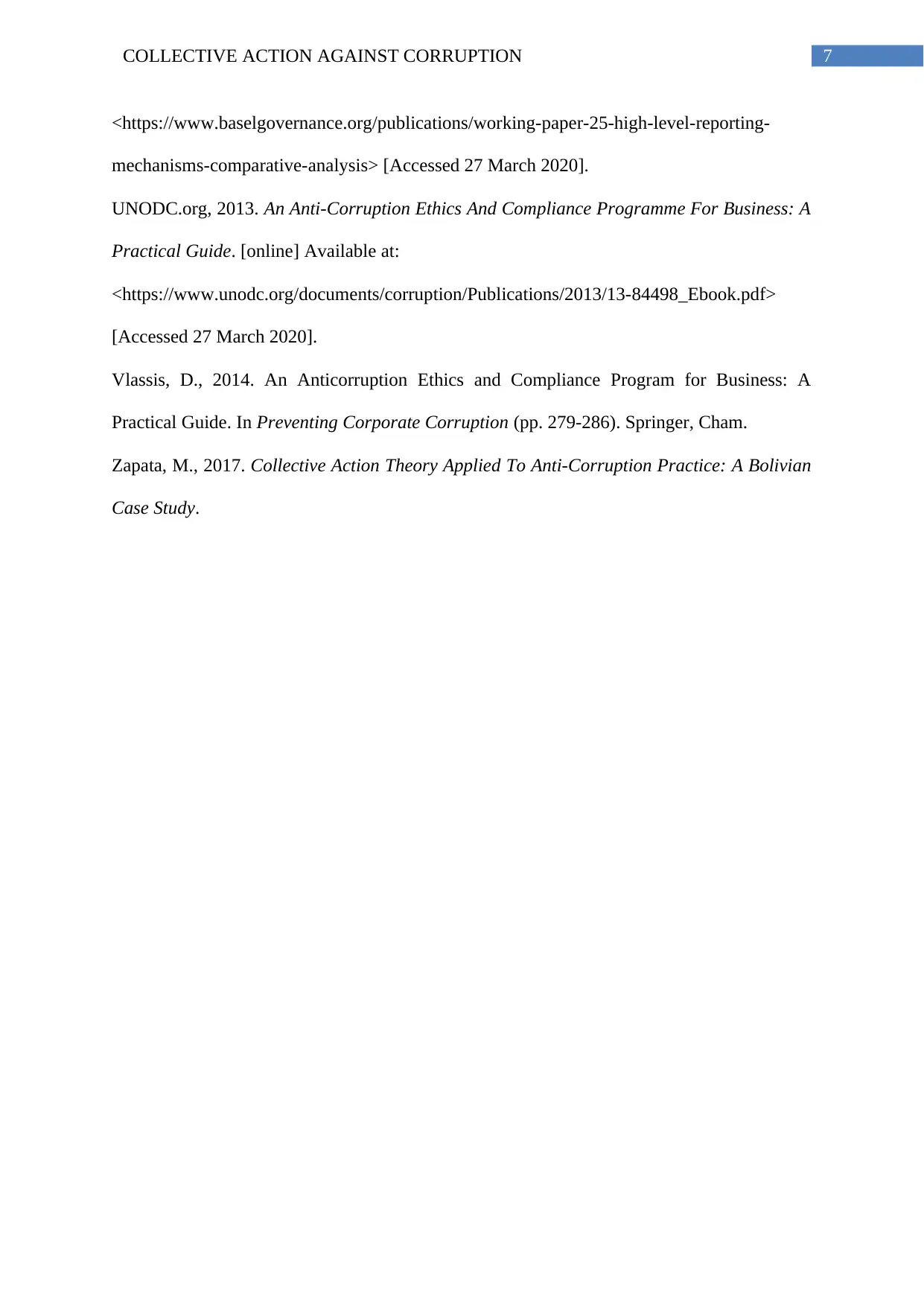
7COLLECTIVE ACTION AGAINST CORRUPTION
<https://www.baselgovernance.org/publications/working-paper-25-high-level-reporting-
mechanisms-comparative-analysis> [Accessed 27 March 2020].
UNODC.org, 2013. An Anti-Corruption Ethics And Compliance Programme For Business: A
Practical Guide. [online] Available at:
<https://www.unodc.org/documents/corruption/Publications/2013/13-84498_Ebook.pdf>
[Accessed 27 March 2020].
Vlassis, D., 2014. An Anticorruption Ethics and Compliance Program for Business: A
Practical Guide. In Preventing Corporate Corruption (pp. 279-286). Springer, Cham.
Zapata, M., 2017. Collective Action Theory Applied To Anti-Corruption Practice: A Bolivian
Case Study.
<https://www.baselgovernance.org/publications/working-paper-25-high-level-reporting-
mechanisms-comparative-analysis> [Accessed 27 March 2020].
UNODC.org, 2013. An Anti-Corruption Ethics And Compliance Programme For Business: A
Practical Guide. [online] Available at:
<https://www.unodc.org/documents/corruption/Publications/2013/13-84498_Ebook.pdf>
[Accessed 27 March 2020].
Vlassis, D., 2014. An Anticorruption Ethics and Compliance Program for Business: A
Practical Guide. In Preventing Corporate Corruption (pp. 279-286). Springer, Cham.
Zapata, M., 2017. Collective Action Theory Applied To Anti-Corruption Practice: A Bolivian
Case Study.
1 out of 8
Related Documents
Your All-in-One AI-Powered Toolkit for Academic Success.
+13062052269
info@desklib.com
Available 24*7 on WhatsApp / Email
![[object Object]](/_next/static/media/star-bottom.7253800d.svg)
Unlock your academic potential
Copyright © 2020–2025 A2Z Services. All Rights Reserved. Developed and managed by ZUCOL.





